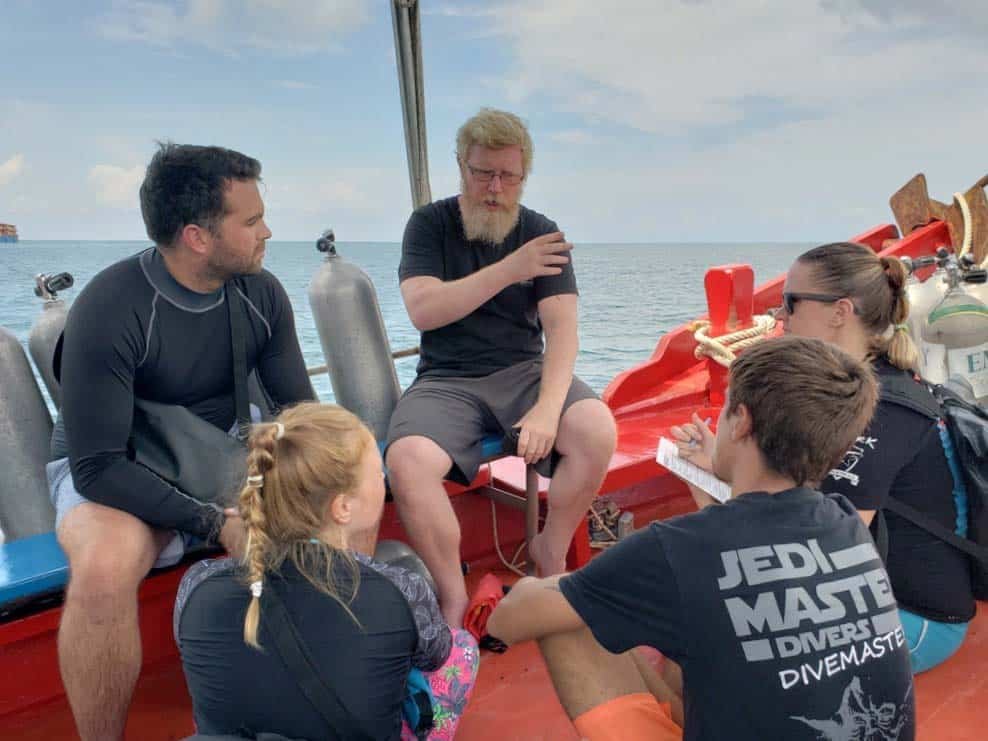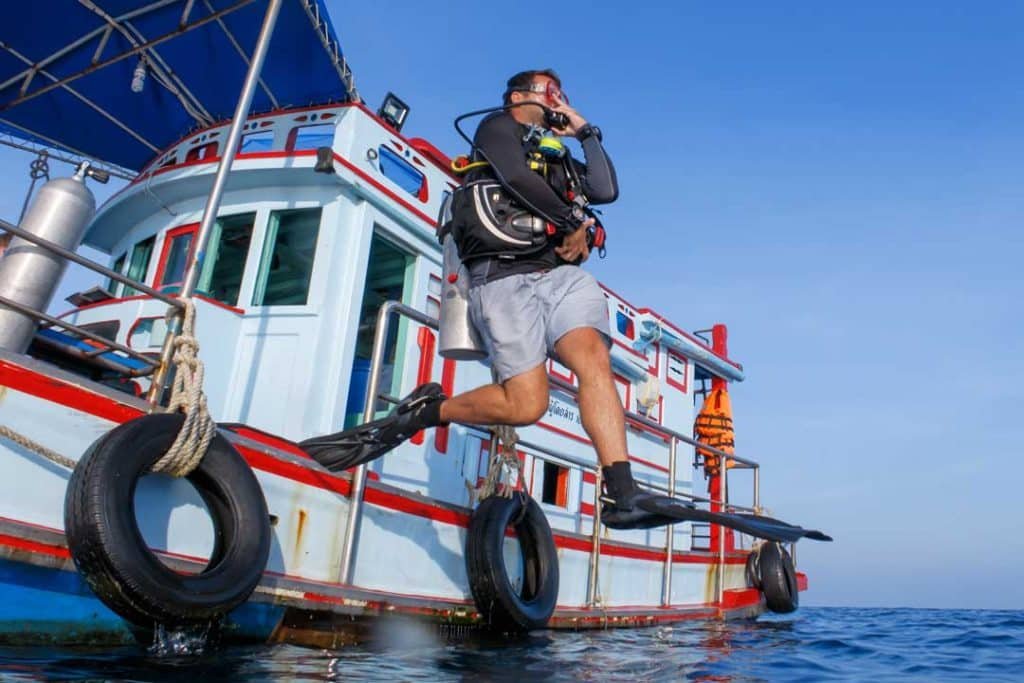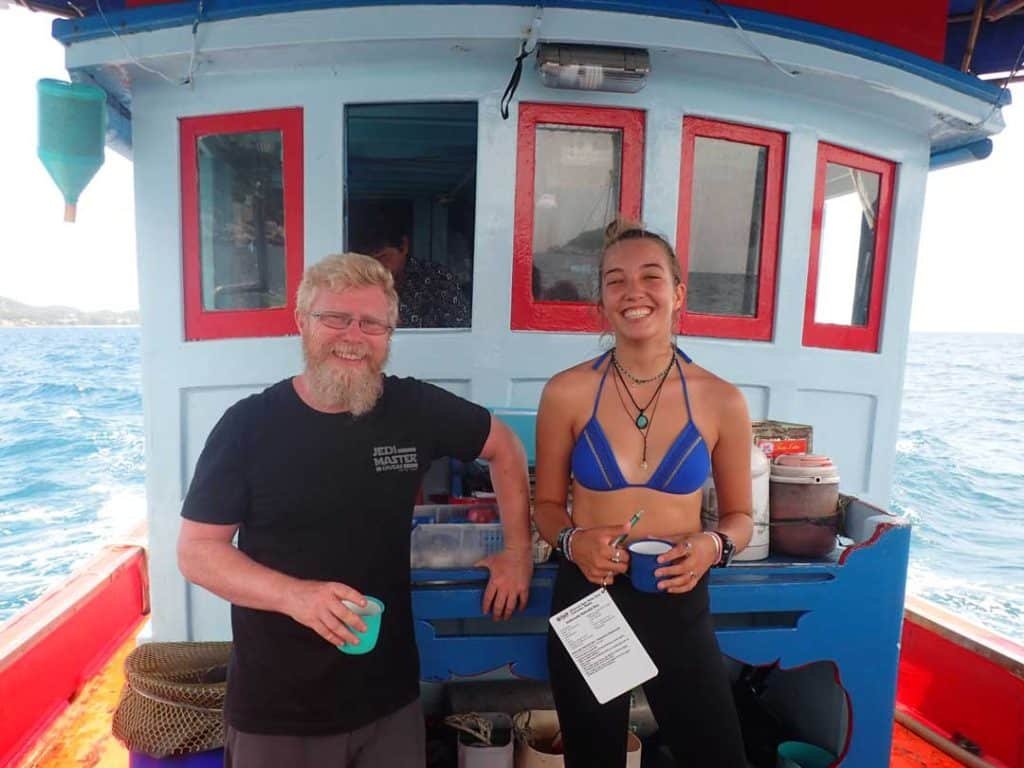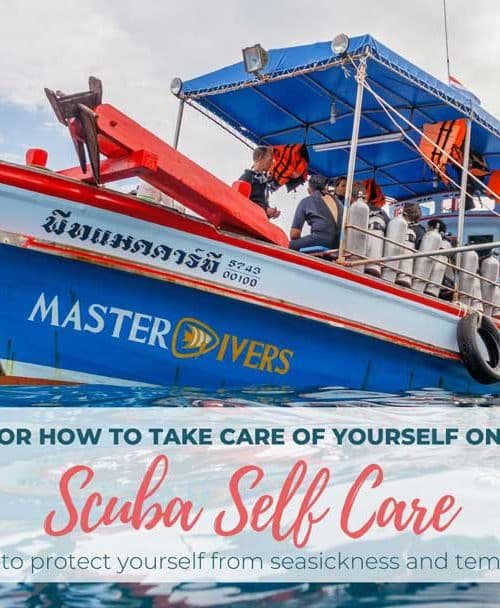One of the first things we learn during the PADI Open Water Diver Course is that as divers, we need to make sure we feel well and comfortable before we dive. Being on the water and under the water is unusual for our bodies, and we should be vigilant in making sure the condition of our bodies does not suffer as a result.
How to take care of yourself when you go diving
Being more exposed to potentially different weather conditions than those we would normally experience on land, we should be mindful of some simple things we can do in the lead up to, and during the dive trip to make sure we feel as well as possible. Ultimately, no one wants to have to deal with the frustrating situation of missing a dive. With that in mind, here are some common things that can be overlooked in the excitement to dive, and we give you our top tips for the things you can do to make sure this doesn’t happen to you.
Seasickness
One of the most common reasons that a diver will have to skip a dive is if they get seasick. Ironically being under the water, where there are no waves and minimal water movement, does help to alleviate symptoms. As we know, diving when we are feeling less than 100% well is not recommended and if you are unlucky enough to suffer with a bad bout of seasickness, it’s likely that the last thing you will want to do is getting kitted up and going for a dive.
Understanding what causes seasickness can help us plan to avoid it. It is essentially balance system stress caused by the reaction of your inner ear balance system to an unfamiliar motion. Thankfully, the system is capable of adjusting, so normally on longer trips like Liveaboards, passengers are usually able to find their “sea legs” after 2-3 days.

The good news is that there are a number of easy precautions you can take to help limit your chance of feeling nauseous, or at least limit the effects if you do.
Before the trip:
- Sleep – Get a good night’s sleep, being tired worsens the effects
- Drink water – Hydrate well over at least 2 days before the trip
- Eat something – Eat light, plain, non-spicy, non-greasy, non-acidic foods before your trip. But do make sure you eat something, an empty stomach is not good for seasickness
- Medication – If you know you are prone to motion sickness, take a non-drowsy anti-nausea medication such as cinnarizine. This is most effective when taken 1 hour before you go on the boat
- Others – If your trip is longer, or you have experienced sea sickness in the past, consider investing in acupressure wristbands, or even a transderm scopolamine patch which is medicated and placed behind the ear. Both help alleviate symptoms of nausea and vomiting.
On the trip:
- Fresh Air – Keep in the fresh air, away from any strong smells like the boat engine, the bathroom, food or fuel. Use a menthol inhaler stick to counteract any unpleasant smells you may still pick up on. Definitely keep well away from anyone else who is sick.
- Positioning – Position yourself closest to the surface of the water and look out at the horizon. On our dive boats this is mid-ship on the lower deck
- Mint – Chew gum – the mint can help settle upset stomachs and chewing seems to reduce the adverse effects of the conflict between vision and balance, which causes seasickness in the first place.
- Again: drink water – Keep hydrated – many suggest that soda or fizzy water is better than still water due to how it feels in the stomach. Avoid sugary drinks.
- Food – Stick to eating plain, salty foods like crackers, banana, green apples and ginger. These foods can help limit or alleviate nausea.
- Mind games – Try a bit of mind over matter – tell yourself you don’t get seasick!
If seasickness does get to you:
Don’t hold it in and make sure you vomit on the leeward (non-windy) side of the boat 😉
Temperature Management
As divers we are generally more exposed to the elements when out on the boat compared with when we are on land. This can mean either excessive sun exposure and heat, or cool wind and rain… Or possibly everything in one day if you’ve ever dived in the tropics! Failure to manage these properly can result in generally feeling bad on the trip, possibly missing a dive, or the worst case can leave you needing additional medical attention.

Hypothermia is when the body’s core temperature drops below the level required for normal metabolic function. Heat exhaustion is when the body’s cooling mechanisms are put under pressure and work a little less effectively. Avoiding both of these conditions is important, therefore the best plan is to be prepared for all the possible conditions and carefully monitor yourself and how you feel during the trip.
Before the trip:
- Once more: drink water – Hydrate and eat well in the run up to the trip.
- Weather – Check the weather forecast or ask your instructor what conditions you can expect and pack accordingly. This should include reef safe sunscreen (sunburn increases the risk and effect of heat exhaustion), a wide brimmed hat and a pale, loose t-shirt for hot days; or a towel and a rain jacket for the cooler days.
On the trip:
- Clothing – Dress for the dive at the correct time – if it’s hot, only do so right before the dive.
- Stay in the shade – If it’s hot, rest in the shade in the surface interval, reapply your reef safe sunscreen and wear your cover up top and sun hat. You can also splash water on your top to keep you cooler.
- You guessed it: drink water – Regardless if it’s hot or cold, drink plenty of water with extra electrolyte powder added to keep hydrated. Dehydration caused by lack of water and by lack of salts are different, so you should be mindful to replace both.
- Adjust your dive time – Water conducts heat away from the body 20 – 25 times faster than air. If you start to shiver when you are on the dive, be sure to let your dive leader know and plan to end the dive if necessary.
- Stay dry & warm – Water takes heat from the body by convection a staggering 1000 times faster than air. If it’s colder, when you get back on the boat, remove your wetsuit at least to your waist, dry your body with your towel and put on your dry top or rain jacket to keep warm.
If you are not able to properly warm up or start to cool down after 15 minutes:
Let your dive leader know so they can assist you as required.

Hydration and Nutrition
From the tips above it’s clear that you can do your diving-self a lot of favours by eating and drinking the right things at the right time before and during your dive trips. Depending on the temperature and the dive conditions, you can easily burn 300-450 calories per hour compared with 50-60 calories per hour at rest, so it’s clear we do need to take energy intake into consideration also. With that in mind, here are our top tips for a healthy diving diet:
- Eat something – First and foremost: Make sure you eat something before you go diving.
- Light foods – Stick to light, low fat, non-greasy foods. Cholesterol is linked to bubble proneness so fatty foods should be limited.
- Snacks for the boat – Fruit, bananas, dried fruit, seeds, salted nuts, ginger biscuits and plain crackers are ideal for replenishing energy between dives. Don’t forget to bring enough to share around!
- Don’t eat too much – To maximize your comfort on the dive, stop eating before you feel too full and don’t eat just before you go into the water.
- Easy digestion – Chew your food well to aid digestion and to limit excess gas production.
- No farty foods – Avoid eating brassicas (broccoli, cabbage, cauliflower, kale etc) as these foods can produce gas during digestion. This may be an uncomfortable issue for divers on ascent if the gas is produced during the dive.
And finally, one last top tip from Master Divers’ Head Instructor Jason:
Keep your gear, weight belt and belongings in a tidy manner and well out of the way on the boat. By far the most common injury we see on the dive boat is a stubbed pinky toe from tripping on gear that is not stored properly.

